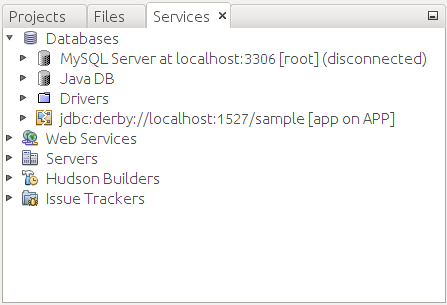

In the Database Config window, change the Connection to Generic ConnectionĬopy and paste the following values into the corresponding fields under the General > Connection section and click on OK URLīack in the Mule Properties, paste the following SQL script into the SQL Query Text field.- ( Running the application, auto - reloading is enabled ).
#Derby db text type plus
Switch back to the Message Flow on the Mule Canvas and click on the Select operation.Ĭlick on the green plus sign in the Basic Settings section next to Connector configuration

In the Spring Config window, fill in the Files field with springbeans.xml and click on OK. Go ahead and click on OK to accept the defaults and proceed.īack in the Listener Mule properties tab, fill in the Path field with the value /customers.Ĭlick on Global Elements in the Mule Canvas. Under the General tab, and in the Connection section, take note of the port. Go back to the Mule Canvas, click the Listener icon, and click on the green plus sign to create a new Connector configuration. INSERT INTO demodb.customers (customerId, companyName,lastName,firstName,phone,addressLine1,addressLine2,city,state,postalCode,country,productNumber,creditLimit) This will create a new schema and a new table in the Derby database. Right click on the folder src/main/resources again and click on New > File and name the file create-db.sql and click on Finish.Ĭopy and paste the following script into the file and save it. You can see that it calls two SQL files in line 22 and 23 to create the database, tables and insert data into those tables. This is used by the Spring module to initialize and configure the Derby database. It should look like the screenshot below. Name the file springbeans.xml and click on Finish Right click on the folder and select New > File In the Package Explorer, expand the src/main/resources folder. In this section, we’ll be creating the scripts for setting up the database and tables as well the Spring bean configuration file used by the Spring module. In the next sections, we’re going to create the database scripts to build the tables and also configure the Spring components that will setup the Derby database.Ĭreate Database Scripts and Spring Bean Configuration Then right-click on the flow with the Authorization filter component and click on Delete Don’t worry about the red error markers, we’ll go back and configure each component in the following sections. Your palette should look like this.ĭrag and drop the following components into the Mule Canvas In the Mule Palette, click on Add Module and drag-and-drop in the Database and Spring modules to add them to the project. Start Anypoint Studio and create a new Mule project by clicking on File > New Mule project.

This post will walk you through the process of setting up Derby in a new Mule project in Anypoint Studio.

#Derby db text type driver
Simply loading the driver starts the database and it stops with the applications.įrom a MuleSoft standpoint, there are multiple applications of leveraging Derby in a project from maintaining state to encapsulating data along with an API implementation. Once deployed, it runs in the same JVM as the application.
#Derby db text type software
It is an open source database developed by Apache Software Foundation.ĭerby provides an embedded database engine which can be embedded in to any Java application. Apache Derby is a RDBMS which is implemented in Java.


 0 kommentar(er)
0 kommentar(er)
